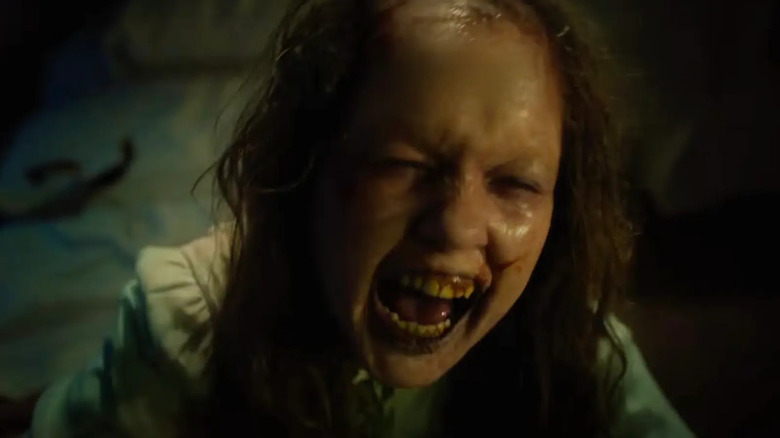The Exorcist: Believer's Truly Abysmal Digital Effects Nearly Ruin The Movie
This article contains spoilers for "The Exorcist: Believer."
William Friedkin's celebrated horror film "The Exorcist" was so popular upon its release in 1973 that it more or less invented a genre. Thanks to "The Exorcist," film audiences around the world know what demonic possession is, what demons look like, and what particular sect of Christian clergyman needs to be called in to take care of the problem. If a loved one begins spewing green slime, speaking in Latin, and levitating above their bed, you best be sure that a Methodist minister will not be called. No, it's Roman Catholic priests or bust.
To pause for a moment on that green slime, however, it's a reference to two moments in "The Exorcist" when the young Regan MacNeil (Linda Blair) weaponized gastrointestinal discomfort toward a visitor. Regan, under demonic influence, projectile vomits pea-green ooze copiously on passers-by. The vomiting effect was achieved through a complex system of tubes, pumps, and face-mounted pouches that spray actors with actual, viscous pre-mixed slime, leaving them messy and needing to clean up between takes. The vomit is legitimately gross — quite intentionally — and its visceral sloppiness adds to the impact of the barf scenes.
Now imagine the same scenes achieved not with pumps and glop, but with ultra-slick, modern CGI effects. It may be immediately evident to many that CGI is simply not as good as practically-crafted barf. While CGI effects have provided audiences with ultra-realistic aliens, spaceships, dinosaurs, and outsize, purple-skinned supervillains when it comes to something as simple as vomit or arterial spray, modern special effects still flounder.
David Gordon Green's "The Exorcist: Believer," currently playing in theaters, eschews actual excreted fluids in favor of demonic CGI clouds. The effects are feeble at best.
The non-horror of CGI blood
As one might predict, "The Exorcist: Believer" climaxes with an intense exorcism scene wherein two 13-year-old girls (Lidya Jewett and Olivia O'Neill) are strapped to chairs and pelted with prayers. Leading up to this climax, both of the possessed girls engage in old-hat demonic shenanigans, like committing blasphemous acts with a crucifix, cussing like sailors, and committing horrifying acts of self-harm. And, yes, there is a brief moment of vomiting.
But overall, "The Exorcist: Believer" remains disappointingly dry and free of blood splatter and rockets of bile. This is an overall detriment to the film at large.
Again, modern CGI is excellent, and some wonderful things have been achieved with it. But when it comes to horror, CGI tends to lessen a film's intended impact. Horror, generally speaking, taps into real-life fears, and most of us fear being stabbed, fear bleeding, and fear actual, physical violence. As such, a real-life knife going into a rubber body is going to have a stronger impact than a knife blade created via advanced animation techniques. Cheaper, too. Any aspiring horror filmmaker can go to a grocery store, buy a watermelon, wrap it in a shirt, and stab it with a real knife to achieve the proper illusion of murder. And it's going to look 100 times better than anything Industrial Light and Magic might cook up.
"The Exorcist: Believer," in refusing to use real blood and real vomit has robbed itself of weight. Indeed, it looks like any number of PG-13-rated ghost movies from the last decade, complete with trite, uncreative ghost images and clouds of darkness that don't seem to exist in the same space as the actors. When the evil leaves no residue, it's decidedly less scary.
And they're not even good
Even very good CGI blood isn't great. It leaves no spots on the clothes. It doesn't drip down an actor's face. CGI blood and vomit typically spray through the air, land off-camera, and vanish forever. There's no puddle to mop up later. Recall in the original "Exorcist" when Father Merrin (Max Von Sydow) had to wash off his vestments during the exorcism, or when Father Karras (Jason Miller) received a vomit splatter to the face. There may have been ways to accurately recreate these moments with computer-based special effects, but it's unlikely the visceral power would remain.
But the CGI in "The Exorcist: Believer" isn't exactly spectacular. The filmmakers aren't taking the time and care needed to create an astonishing demonic moment that will burn into the audience's memory. They're essentially inserting CGI textures into a scene that is framed up and photographed just as incidentally as any other scene in the movie. Had Green locked down his camera in a wide angle, and presented a computer effect with wonderment and clarity — the vomit-and-blood version of the T. Rex from "Jurassic Park" — then at least the film would have provided the audience with something memorable. David Gordon Green, however, doesn't do that. He is not the same kind of filmmaker as Steven Spielberg.
"The Exorcist: Believer" opened to only $27 million domestically, which may be frustrating to distribution studio Blumhouse, who paid $400 million for the "Exorcist" film rights. "Believer" is meant to be the first of three new "Exorcist" movies, and David Gordon Green is a talented filmmaker. Perhaps he will be wiser about his CGI effects in the future.


